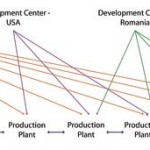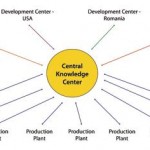The demand for automobiles has been on the rise in the emerging economies of Asia and South America, which means new markets for the world’s automotive parts manufacturers. This is good news for business but it also presents many new challenges in logistics, design development, and manufacturing quality assurance—and, the competition is fierce. Becoming more efficient to meet the growing demand, while maintaining quality, is a must.
Michael Ford, Mentor Graphics Corp., Newbury (UK)
The engineers at the Electronics Business Division of the Hella KGaA Hueck & Co. Group have been at the forefront of automobile electric innovations since 1957. Today, they are providing safety critical systems, fuel efficiency management systems, and controls for driver comfort and assistance. They have a reputation for supplying high-volume, high-quality parts; for example, a large part of their business is to design and manufacture parts for companies such as General Electric that end up in cars made by BMW and Volkswagen.
Consistently high quality
The challenge the Hella engineering groups faced with this “new world order” is to ensure that the exceptionally high quality demanded by their customers could be produced consistently, right from the first production build, anywhere in the world. The frequency of new products is also a key issue, with literally hundreds of new models coming in every year. The cycle time from design release to production start has to be a couple of days.
As Ernst Albert from Industrial Engineering, explained, “When these new markets opened up, we expanded our design and manufacturing facilities to have local manufacturing capability, which dramatically reduces the length of the supply chain and provides maximum flexibility to our customers.”
They have development centers with production facilities in Germany, the United States, China, and Romania, with additional production plants in India, Mexico, and South Korea. Some parts are produced at only one plant, and some parts are produced in multiple plants. Every product is assigned to a lead plant, the one where a product order was originally taken from a customer; if it was for a customer in China, then the lead plant would be in China. If parts were to be made at other locations as well, then the specifications would be sent from the lead plant to the other manufacturing facilities.
Not only did they face this challenge of coordinating design and manufacturing between geographically dispersed locations but also each of the manufacturing sites has different SMT equipment, supplied from different vendors, with many different configurations. Materials parts geometry information was held at each site by the local SMT process engineer teams. The machine and parts library data files were kept locally, and the local engineers crafted these libraries for their specific needs. This required highly trained engineers to be located at each site and was not scalable.
This meant that the knowledge for design and manufacturing of a part often had to be translated from one platform to another, and much work had to be redone as it was passed from one team to another. Nevertheless, product transfers have to be error-free, even when they are dispersed to multiple sites simultaneously and each site has local people, with minimal line machine verification time to be able to ensure minimum production interruption and maximum production time.
Albert, who is located in the Hella facility in Lippstadt, Germany, has instituted a novel and elegantly simple solution to help the company better address these challenges. Using the Mentor Graphics Valor Process Preparation software to manage and process all the product design and manufacturing data, Albert created a central knowledge center, located in the company’s Romania facility.
Centralized information
The first step of the project was to manage and standardize the data coming from all of the different design centers and to create standard product models ready for production. The software is able to take the differing data formats that contain both the design data and bill of materials (BOM) parts data so that a central database can be established with consistent ready to-use, error-free data that all manufacturing engineering functions can access. All released design and BOM data now flows into the central knowledge center, together with planning information for the product introduction at designated sites. See the first figure which shows what the design to production flow used to look like, the second figure shows what it looks like now. The small highly skilled engineering team in Romania optimizes all the data coming in. As changes are made at the various locations, they are incorporated into the central knowledge center database so that everyone is working with the same information.
The Romania team uses the Valor software to import and merge the design and BOM information and to create standard product model data. They also use the parts library management function to centrally create and manage a single global materials parts library that contains precise geometry information of each part number, which previously was managed separately at the individual sites by each local SMT process engineering team, often multiple times, on each machine vendor’s platform.
The flow of all new product data goes into the central database where the Romania engineering team accesses the released files along with instructions for the target manufacturing sites and assembly lines. They then prepare all the SMT machine data for any of the sites or target lines. Once completed, these pre-validated product data files are held in the central database as ready-to-use job files, and the local site is notified that they are accessible.
Software as solution
Albert said, “It is now easy to change production to new target lines with just 10 minutes to prepare the data for transferring to a new target line with new machine programs. We now have 100% accurate SMT machine placement orientation and centroids. And the time taken by local site engineers to validate new programs has been reduced by 80%, saving both engineering time and valuable line time by using Valor Process Preparation.”
With libraries that are accurate and contain verified data from their skilled engineers, available for all sites to access, they have essentially captured knowledge that wasn’t easy to replicate. The central library structure has now eliminated the need to maintain local libraries. Each site can access the master database, sharing the learned knowledge with a high degree of confidence that it is error-free. Using the software’s auto-generation function, new product setups, as well as existing product transfers, can be made without error, even when multiple sites are making the same products at the same time on different machine platforms and configurations. The data delivered in all formats to all platforms is derived directly from the same standard library. In order for the engineers at dispersed facilities to ensure for themselves that the programs and files transferred from the central knowledge center in Romania can truly be pre-verified and ready to go, they run “virtual sticky tape” provided by the software at the later stages of production readiness. This virtual simulation of the placement programs matches the CAD board image with the precise material parts dimensions and the actual machine program parameters. Automatic error detection immediately flags possible issues to be addressed. The “virtual sticky tape” function run on all new products simulates the actual placements to be made by the machines, superimposed on the image of the designed product to precisely check placement locations, component dimensions, and rotations. It has the same effect as running a sample board, placing the components on real sticky tape, but is much faster and easier, without using any line-time.
Albert summed up their achievement, “The result is excellent. Seven manufacturing sites with hundreds of new products being introduced each year are all managed by the central knowledge center team that consists of just three engineers based in our office in Romania. This has been enabled by the corporate-wide implementation of the Valor Process Preparation solution.”
SMT Hybrid Packaging
Booth 7-208
Michael Ford is Senior Marketing Development Manager with the Valor division of Mentor Graphics Corp. He joined Valor in 2008. He focuses on delivering solutions based on the Lean Thinking methodology. Prior to joining Valor, Michael spent a number of years managing Lean Manufacturing solutions for Sony. Michael graduated with a degree in electronics from the University of Wales. In his spare time he enjoys rock and popular music in addition to West End theatre productions.
Zusammenfassung
Der Artikel zeigt auf, wie sich Entwicklung und Produktion der Elektronikfertigung an verschiedenen Standorten eines internationalen Automobilzulieferers effizient managen lassen. Mithilfe einer innovativen Software werden nun die Daten von einem zentralen Ort für eine transparente Produktion verwaltet.
L’article démontre comment le développement et la production de la fabrication électronique peuvent être gérés de manière efficace sur différents sites d’un fournisseur international pour l’automobile. Avec l’aide d’un logiciel innovant, les données sont désormais administrées à partir d’un site centralisé pour assurer une production transparente.
Share:











